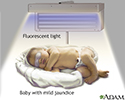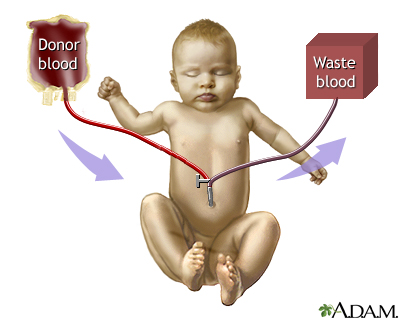Exchange transfusion
Hemolytic disease - exchange transfusionExchange transfusion is a potentially life-saving procedure that is done to counteract the effects of serious jaundice or changes in the blood due to diseases such as sickle cell anemia.
The procedure involves slowly removing the person's blood and replacing it with fresh donor blood or plasma.
-
Description
An exchange transfusion requires that the person's blood be removed and replaced. In most cases, this involves placing one or more thin tubes, called catheters, into a blood vessel. The exchange transfusion is done in cycles, each one most often lasts a few minutes.
The person's blood is slowly withdrawn (most often about 5 to 20 mL at a time, depending on the person's size and the severity of illness). An equal amount of fresh, prewarmed blood or plasma flows into the person's body. This cycle is repeated until the correct volume of blood has been replaced.
After the exchange transfusion, catheters may be left in place in case the procedure needs to be repeated.
In diseases such as sickle cell anemia, blood is removed and replaced with donor blood.
In conditions such as neonatal polycythemia, a specific amount of the child's blood is removed and replaced with a normal saline solution, plasma (the clear liquid part of blood), or albumin (a solution of blood proteins). This decreases the total number of red blood cells in the body and makes it easier for blood to flow through the body.
##RemoveMe##
-
Why the Procedure Is Performed
An exchange transfusion may be needed to treat the following conditions:
- Dangerously high red blood cell count in a newborn (neonatal polycythemia)
- Rh-induced hemolytic disease of the newborn
- Severe disturbances in body chemistry
- Severe newborn jaundice that does not respond to phototherapy with bili lights
- Severe sickle cell crisis
- Toxic effects of certain drugs
##RemoveMe##
-
Risks
General risks are the same as with any transfusion. Other possible complications include:
- Blood clots
- Changes in blood chemistry (high or low potassium, low calcium, low glucose, change in acid-base balance in the blood)
- Heart and lung problems
- Infection (very low risk due to careful screening of blood)
- Shock if not enough blood is replaced
##RemoveMe##
-
After the Procedure
The patient may need to be monitored for several days in the hospital after the transfusion. The length of stay depends on what condition the exchange transfusion was performed to treat.
##RemoveMe##
References
Costa K. Hematology. In: Hughes HK, Kahl LK, eds. The Johns Hopkins Hospital: The Harriet Lane Handbook. 21st ed. Philadelphia, PA: Elsevier; 2018:chap 14.
Josephson CD, Sloan SR. Pediatric transfusion medicine. In: Hoffman R, Benz EJ, Silberstein LE, et al, eds. Hematology: Basic Principles and Practice. 7th ed. Philadelphia, PA: Elsevier; 2018:chap 121.
Maheshwari A, Carlo WA. Blood disorders. In: Kliegman RM, Stanton BF, St. Geme JW, Schor NF, eds. Nelson Textbook of Pediatrics. 20th ed. Philadelphia, PA: Elsevier; 2016:chap 103.
Watchko JF. Neonatal indirect hyperbilirubinemia and kernicterus. In: Gleason CA, Juul SE, eds. Avery's Diseases of the Newborn. 10th ed. Philadelphia, PA: Elsevier; 2018:chap 84.









